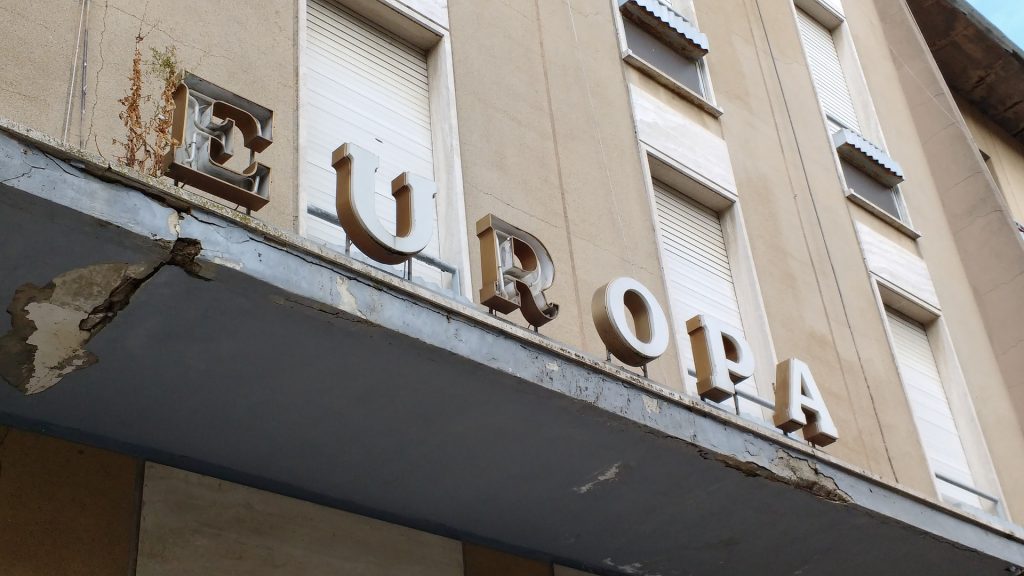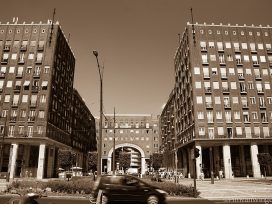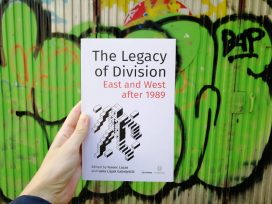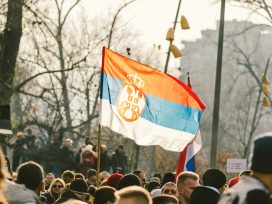Three decades ago the division of the continent did not mean the same as it did in 1959. One could therefore say that the idea of two Europes, East and West, is of limited validity, both because of the short time span during which it was supposed to be widely accepted, and because of its uncertain reach. Seen from Spain or Portugal, Greece or Ireland, the Iron Curtain was relevant, but not the only internal border on the continent. Seen from Budapest, Prague, Bratislava or Warsaw, the so-called Eastern Bloc was far from united. The Soviet Union was clearly not part of the shared space, and the idea of Central Europe was used to underline the distinctiveness of the countries that now belong to the Visegrád Group – a group established just eighteen months after Tadeusz Mazowiecki became the first non-communist head of government in a Warsaw Pact country.
I would therefore suggest that the idea of a coherent Eastern Bloc, and the neglect of various types of internal differences, are the first misperceptions in the West – at least in those countries which launched the European Communities. This is why the tale about the collapse of the communist regimes has devoted limited attention to Central Europe until today, apart from the efforts of a nano-community of specialists and of the local populations, who are often not taken into consideration. The ‘Fall of the Berlin Wall’ occurred months after the changes in Poland or Hungary, not to mention Yugoslavia, and yet it still is a perverse catchphrase. It erases the Central European dimensions of the hopes and mobilizations that stem from that time, focuses on great power games instead, awarding Germany the role of epicenter of this world-historical event.
Starting points
A global perception of ‘communist countries’ presumed that people led inferior lives there compared those of westerners, because of what János Kornai called ‘shortage economies’, and due to limited access to information and opportunities to travel abroad, as well as to the lack of freedom of expression. This everyday feeling about a better life in the West was refuelled on a regular basis by various political actors and in accordance with national political landscapes in the West. Yet the absence of unemployment, reduced income differences and wealth gaps, and a respectable level of elite training in Central Europe did have an influence on Western European societies (and beyond), apparently limiting the drive of capitalism towards inequality. This implicit ‘dialogue’ was clearly denied on many grounds, and these denials enticed many people away from actual curiosity about the other side of the Wall. When contact occurred via tourism, for example, established mindsets efficiently confirmed both feelings of superiority and frustrations, which in turn often generated attempts to reverse hierarchies.
The Helsinki conference (1975) added a new colour to this picture. After World War II, Europe as a whole was reduced to a non-actor on the geopolitical map and none of its leading powers kept pace with the superpowers, except in a social perspective. Military power and economic leadership clearly followed a different path from European welfare-mindedness. Among the parties at Helsinki, it was made clear that Europe was to be a kind of social and cultural island deprived of self-assertive capacities. But the message about peace and broader human rights concealed if not obfuscated Europe’s loss of momentum. And who could have opposed this?
The fascination with (or disgust for) great powers, often meaning the cult of US strength and Ronald Reagan, the anthropological divide imposed by leading ideological frameworks, and the refusal to face the decline of the continent are characteristic of the cascade of misperceptions surrounding the period from 1988 to 1991. But the ability to overcome the East–West divides already existed throughout these periods, both among various sectors of all European societies and various social groups. The mobility of computer science specialists after 1989 is a case in point. I could suggest another take on the ‘divide’ though: we should try to measure how relevant it really seemed to the various historical actors, not only on an ideological basis, but also on a social and cultural one?
If the intensity of existing common practices (the consumption of music in many guises, food and diet, folkdance, choirs, literature, TV series, etc.) were to be represented on the same map as political and ideological perceptions of the ‘other’, then perhaps it would help highlight the many contradictions across the continent. One could be a Reaganite who loved Russian music and a fierce Polish Catholic who despised French state capitalism but loved French culture and hated Germans, even though these ‘perceptions’ would be hard to document, all the more so if one took into account the practices of tennis or hunting, along with the international contacts linked to them. On a more collective level, it is quite obvious that when it came to the Catholic Church, Poland was not in any way excluded. Even in Czechoslovakia in 1988, the Church was able to mobilize well beyond the direct reach of religion. At the same time, religious affinities were largely deceptive. But this could apply to many situations and well beyond the European continent.
What is it that actually characterizes our internal European self-deceptions when it comes to 1989? The first idea worth considering may be that beyond the differences between East and West, there is a potential identification trap, the desire for a miracle of sorts. This is connected to the idea of a shared cultural heritage (starting with the Bible and with Ancient Greece and Rome), of a similar past, notwithstanding the internecine wars on the continent or far away from it, and sometimes to a racist bias (consider perceptions of Roma people across Europe, for example). This trap or desire is in some instances reinforced by basic similarities in schooling and by a cult of knowledge (at least on the level of paying lip service to knowledge). All of this can either be considered a humanist plus, or a reaction to the continent’s decline. Whatever the motives, anyone travelling in western and central Europe may well have experienced the strength of tales that make sense of the past accordingly, albeit often not in particularly coherent ways.
Complex spatial dynamics
In January 1989 the Hungarian Socialist Workers’ Party acknowledged the fact that the ‘counter-revolution’ of 1956 had in fact been a popular uprising. If we look at the three decades since, it’s fairly easy to see that the great powers, anthropological biases, the denial of Europe’s decline and related mutual illusions about the parties involved are still effective engines for cross-(mis)perceptions. Nevertheless, the fuel is no longer the same, and the gears seem to be out of control; the map is no longer the same either (borders, as well as infrastructure, have undergone fundamental changes), so the question now concerns the compass. How to navigate a transformed continent?
An extended Central Europe, including the Baltic States, is both inside the EU (with Bulgaria and Romania having joined in 2007, and Croatia in 2013) and outside it (Belarus, Ukraine, Moldavia, Serbia, Bosnia-Hercegovina, the possible future North-Macedonia, Montenegro, Kosovo and Albania). The borders within the Schengen zone do not have the same meaning as outside it. Among the 19 members of the eurozone are Estonia, Latvia, Lithuania, Slovakia and Slovenia. Montenegro and Kosovo also use the euro as their national currency. And not even the Germans seem to want to return to the Deutschmark. Therefore, we are confronted with very complex spatial dynamics. Older compasses can no longer be relied upon.
Three questions are usually raised at this point: What about the EU? Is there in fact a memory divide concerning the Holocaust (and the ‘crimes of communism’)? And what about democratic values, openness, and showing consideration towards asylum seekers? A common tale since 2015 and the erection of the Hungarian ‘wall’ is to be heard in the West: these ‘eastern peoples’ are democratically underdeveloped, selfish, and antisemitic. The counter-tale is no less crude: these westerners are rich but no longer true Christians, they are selfish, show a preference for multiculturalism that allows them to get even richer, and want to force Muslims on us while overemphasizing the Holocaust and forgetting about the crimes of communists (often attributed to Jews, by the way). Both of these basic perceptions are present in Polish and Hungarian state media and in mainstream western views, and thus the concept of ‘Eastern Europe’ has returned to the French press, for example, while that of ‘Central Europe’ has disappeared.
And yet, sovereignist ideologues all throughout Europe adopt Viktor Orbán’s views or at least hint at Orbán quite often. This could show that the old divide no longer exists. But besieged Hungary or Poland may as well be more a tool than an actual model in a cross-European game. So let us return to the three questions instead.
What sense does the EU make?
Seen from Greater Central Europe, including Ukraine for example, the EU is the only stable magnetic pole in the power games played by Russia and the United States. Neighbouring EU member states show how everyday life could improve, far away from the Russia-oriented provinces to the East. People in Ukraine died for the hopes of some sort of enhanced friendship with the EU. Even in Hungary or Poland, the attraction of the EU remains strong.
The euro also makes sense for many Central Europeans. It means a major change, as the EU did not exist in 1989, unlike NATO, which has been extending its territory even since, but its current reach seems to raise many doubts today, with Turkey, a major player, half in and half out for the past two years. This is to say nothing of the unpredictability of the United States. As international nuclear treaties unravel, not least between Russia and the United States, Washington is considering weakening the security shield over Europe, a major shift that deserves proper scrutiny. The West is no longer the old West. Internal solidarity is gone.
But the ability to react to such a shift is limited, at least in the collective consciousness of European peoples. The proclivity to dream of a privileged US shield (Poland) and attempts to turn to Moscow for security and money (Hungary periodically since 2010) do not point to a clear central European trend, as nowadays Italy seems to look towards Russia for the same things, while Brexiteers continue to look across the Atlantic. But it is hard to make sense of dreams, contradictory steps, and pretences of sovereignty while the longing for foreign patronage and more cash for local elites persists. Geopolitics in 2019 do not resemble geopolitics from 1989. China’s GDP is ten times that of Russia, whereas in 1990 the USSR was on an equal footing with its eastern neighbour. But I would not say that these uncertain logics of international cronyism overrun EU dynamics, whether bottom-up or top-down.
The EU certainly makes a difference. Orbán’s governmental campaign against Brussels acknowledges this fact, as does the popular demand echoed during the demonstrations started on 12 December 2018, which called for a European Public Prosecutor to deal with the rising corruption in Hungary. This initiative was scarcely referred to, if at all, in government controlled state media or in the commercial media dominated by Fidesz; neither were the rest of the demands, such as independent courts and public media, or the reduced overtime for policemen, or the overturning of the ‘slavery law’. The EU now has to openly take a decision on whether to impose respect for the rule of law. Therefore, part of central Europe now has an agency, a leverage that only the EU could provide it with, and there is a certain pride amongst central European sovereignists about this. The intention of Poland and Hungary to lead a ‘cultural counter-revolution’, as expressed by these countries’ leaders in September 2017, is certainly unheard of, looking back at 1939, 1914 or 1789. This is not to imply anything at all about this counter-revolution’s prospects, simply to remind us of the unexpected changes since 1989.
In the permanent shadows of the Holocaust
When considering how the Holocaust is discussed, we also notice incredible ‘turns’ which surpass European perceptions. The actors and the stakes in the story have changed. Moving away from a perpetrator-centred vision, historians are now writing a story where all actors are taken into account, including witnesses. As the focus shifts to smaller groups – particular professionals, villages, or military units for example – responsibility can no longer be generalized as easily as thirty years ago, and neither can heroism be so easily attributed to larger groups. Agency has been redistributed. As the geography of the Holocaust is mostly central European, this change has provoked many shocks in the region. But whereas US historians have only recently started to pay more attention to the Évian conference of July 1938 (by which time Hitler was already certain about the lack of US and international solidarity with German Jewry), France waited until Jacques Chirac’s speech in 1995 to officially acknowledge any responsibility for the extermination of Jewish people. And even though Hungarian historians made the case clear regarding Hungary long before 1995, the current official point of view is in contradiction with the prevailing view of scholars.
The Polish case is of special interest. The country’s German occupiers refused any form of Polish statehood. And for as long as historians of the Holocaust considered the only major agent involved to be Nazi Germany, almost every Pole simply had to be on the good side – all the more so because Poland had been ‘betrayed’ by France and England in September 1939. So, in this discourse, Poland was a country of heroes, period.
Politicians did not immediately notice the agency-turn in scholarship on the Holocaust. In Poland, among other countries, this turn eventually prompted a special inquiry into what happened to the Jews who escaped the ghettos and the extermination camps in 1943 and 1944. A few hundred thousand survived in hiding. Which is where the massive agency of (non-German) non-Aryans, that is mostly ethnic Poles comes into play, as do the inescapable limits to heroism on a day-to-day basis. In the case of Poland, the revision of the entire country’s heroic self-image is at stake, not to mention the so-called ‘History Politics’ promoted by the Law and Justice Party (PiS). The new focus discredits the tale of exceptionality, and so a political question arises from an essentialist’s point of view.
Perspectives on the Holocaust show a tremendous cross-continental evolution that no doubt has a strong Central European flavour. But it is not one-sidedly so. The POLIN Museum of the History of Polish Jews in Warsaw delivers a unique message of a common millenary history and refuses to define ‘the Jew’. It runs an enormous educational programme and has an impact well beyond Europe. To conclude about the Holocaust, which is just a part of the story presented at POLIN, I would highlight that sometimes tensions are more open and violent in Central Europe, but the resulting confrontations can be fruitful, and they often travel across Europe and beyond in reconfigured ways. Such a circulation of ideas and the permeable world of sensitivities lead me to my last point, the democracy issue.
Nonsensical ‘democratic genes’
Path dependency debates have a long tradition. The anthropological question runs like this: is an authoritarian regime truly inescapable for future generations? If we consider Germany or Italy, apparently not. The history of humanity is about putting an end to slavery, gender gaps, domestic violence, casts and orders (fate by birth), and the like, as social divides change shape. So why should communism induce a post-mortem habitus, to use a term of Bourdieu’s? It seems bizarre even to raise the question. Should we assume that the election of Donald Trump implies that slavery will make a comeback and the triumph of everlasting racism or eternal male domination? In a peculiar way, such thoughts tend to reveal the lasting impact of a notion of natural order(s). When analysts resort to national or religious characteristics, it is proof of their blindness towards dynamics. We need patience and time to understand where agency is today, and what social processes are at work.
To conclude, on the basis of these three elliptical insights, there is a new remapping of Europe, and the East-West divide appears to have lost a lot of its former importance, if it is not already fading away altogether as the continent itself gradually loses ground. Historical divides have not been transformed in the way that was hoped and expected. Democracy and the market were supposed to bring wealth and, in turn, further commitment to democracy, a dream which had never before been realized in such circumstances. The whole continent morphed very fast. Social inequality skyrocketed, but so did investment. Maybe we have to look beyond the linear scheme dominated by borders, states and timelines.
In order to reconsider the logics of space, we could start by testing cognitive biases imposed by contiguity and a relative lack of contact across ‘the Wall’. Central Europe is a distinct player, or at least a place where, thanks to the EU leverage, specific actors now try much harder to make a difference than they did during recent decades.
If we look at the major and globally accepted historiographic accomplishments regarding central Europe in the last decade – that is, primarily, Timothy Snyder’s Bloodlands and his work on the Holocaust – we still have much to do when it comes to properly exploring the relationship between place and mindsets. I consider this a major challenge for the community of historians and social scientists. The stakes are high: all nationalist blueprints fuel the decline of cross-continental understanding, and this means that specialists in central Europe operate under growing pressure today. Offering tools and polemical debates to understand how continental history grinds down its children inside a common engine, and how the automobile it powers is to navigate a changing landscape, could help all actors increase and enhance their agency, especially at a time when shadow-boxing seems to be such a common practice among so many politicians. For in this matter, there is no East-West divide, just smoke and distorting mirrors.







